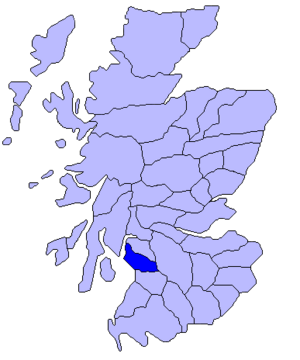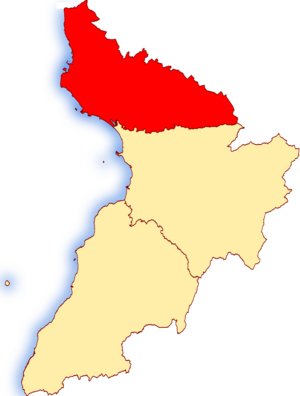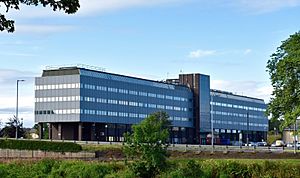Cunninghame facts for kids
Cunninghame (which is Coineagan in Scottish Gaelic) was an important area in Scotland. It was first a historic "comital district," which means it was an area linked to a count or earl. Later, from 1975 to 1996, it became a special local government "district" within the Strathclyde Region.
Contents
What is Historic Cunninghame?
The name Cunninghame, and the family name Cunningham, has an interesting history. The end part, -hame, comes from an old English word meaning "home" or "village." The first part might come from an old English word for "king" (cyning) or a Gaelic word for "rabbit" (coineanach).
Irvine, a town that was once a capital of Scotland, was the main town of Cunninghame. This shows it was a very important place. The family crest of the Cunninghams even includes a unicorn, which is usually only used by the Crown (the King or Queen) and a few special clans.
Where was Historic Cunninghame Located?
The old district of Cunninghame had clear borders. To the north and east, it was next to the districts of Renfrew and Clydesdale. To the south, the River Irvine separated it from the district of Kyle. To the west, it met the Firth of Clyde, which is an arm of the sea.
Cunninghame became one of three main areas, or "bailieries," within Ayrshire. Ayrshire was a larger region, like a county. Cunninghame was in the north, along the River Irvine. Kyle was in the middle, along the River Ayr. And Carrick was in the south, along the River Doon. By the 1700s, these three areas were just known as "districts" or "divisions" of Ayrshire, even though they didn't have their own formal governments anymore.
In the late 1800s, Cunninghame was described as including several parishes (like local church areas). These included places like Ardrossan, Beith, Dalry, Irvine, North Ayrshire, Kilmarnock, and Largs.
Cunninghame as a Local Government Area
Quick facts for kids Cunninghame |
|
 Cunninghame District within Scotland |
|
| Geography | |
| Status | District |
| HQ | Irvine |
| History | |
| Created | 16 May 1975 |
| Abolished | 31 March 1996 |
| Succeeded by | North Ayrshire |
 |
|
The name Cunninghame was used again in 1975 for a new local government district. This was part of a big change to how local areas were run in Scotland. Cunninghame became one of 19 districts in the Strathclyde region.
What Areas Did the District Cover?
This new Cunninghame district included several towns and areas from the old counties of Buteshire and Ayrshire. Some of the places it covered were:
- Ardrossan
- Arran
- Cumbrae
- Irvine
- Kilbirnie
- Kilwinning
- Largs
- Millport
- Saltcoats
- Stevenston
- West Kilbride
When Did the District End?
The Cunninghame district stopped existing in 1996. This was because of another change in local government. The area then became the North Ayrshire council area, which has almost the same borders as the old Cunninghame district. Today, the name Cunninghame is still used for two areas in the Scottish Parliament, called Cunninghame North and Cunninghame South.
Where Was the Council Based?
The Cunninghame District Council had its main office at Cunningham House in Irvine. This building was specially built for the council in 1975. After the district was abolished in 1996, the building became the headquarters for the new North Ayrshire Council.
What Was the District's Coat of Arms?
The Cunninghame District Council received its own coat of arms in 1979. A coat of arms is a special design that represents a family, city, or organization.
- The main part of the design was a black "shakefork." This came from the coat of arms of Clan Cunningham.
- On the left, there was a design from the old town of Irvine, which was based on the royal arms of Scotland.
- On the right, there was an old ship, which had been used in the arms of Bute County Council and Arran District Council.
- Above the shakefork, there was a leopard's head holding a weaver's shuttle in its mouth. This represented the weaving industry that was important in the area.
- The motto of the district was Sense and Worth.
- The whole design was topped with a special gold crown, which was used for district councils, and had thistle-heads on it (the thistle is a symbol of Scotland).
See also





